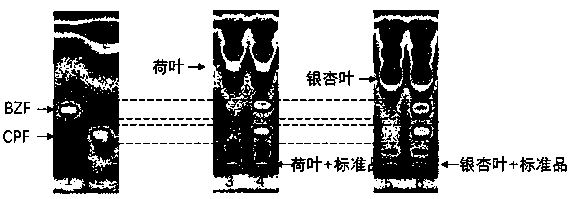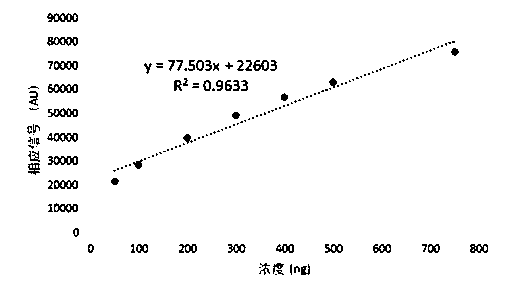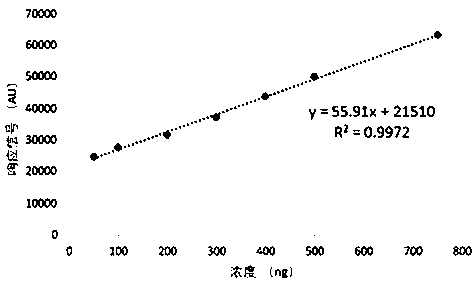Adulteration detection method to fibrates lipid-lowering chemicals of tea by high-performance thin-layer chromatograph(HPTLC)-bioluminescent method
A high-efficiency thin-layer chromatography and bioluminescence technology, applied in the field of food testing, can solve problems such as background interference and lack of selectivity for multiple targets
- Summary
- Abstract
- Description
- Claims
- Application Information
AI Technical Summary
Problems solved by technology
Method used
Image
Examples
Embodiment 1
[0040] (1) Preparation of simulated seawater liquid and solid medium: Prepare simulated seawater liquid medium according to the following formula: 30 g / L NaCl, 5 g / L Na 2 HPO 4 , 5 g / L KH 2 PO 4 , 3 ml / L glycerin, 5 g / L peptone, and 5 g / L yeast extract. After adding 1 L of ultrapure water and stirring to dissolve, adjust the pH value of the prepared liquid medium to 7.5±0.2 with 1 mol / L sodium hydroxide aqueous solution, and then use a high-pressure steam sterilizer to sterilize at 121°C for 15 minutes. The prepared liquid culture medium is packaged and stored in the refrigerator for later use, and can be stored at 4°C for 7 days when not in use.
[0041] (2) Cultivation and preservation of luminescent bacteria strains: inoculate the luminescent bacteria frozen and preserved in glycerol into the Erlenmeyer flask containing 100 mL of liquid medium prepared in step (1). The mouth of the bottle is wrapped with sterilized four-layer folded tinfoil to ensure that external oxyge...
Embodiment 2
[0052] (1) Preparation of simulated seawater liquid and solid medium: Prepare simulated seawater liquid medium according to the following formula: 30 g / L NaCl, 5 g / L Na 2 HPO 4 , 5 g / L KH 2 PO 4 , 3 ml / L glycerin, 5 g / L peptone, and 5 g / L yeast extract. After adding 1 L of ultrapure water and stirring to dissolve, adjust the pH value of the prepared liquid medium to 7.5±0.2 with 1 mol / L sodium hydroxide aqueous solution, and then use a high-pressure steam sterilizer to sterilize at 121°C for 15 minutes. The prepared liquid culture medium is packaged and stored in the refrigerator for later use, and can be stored at 4°C for 7 days when not in use.
[0053] (2) Cultivation and preservation of luminescent bacteria strains: inoculate the luminescent bacteria frozen and preserved in glycerol into the Erlenmeyer flask containing 100 mL of liquid medium prepared in step (1). The mouth of the bottle is wrapped with sterilized four-layer folded tinfoil to ensure that external oxyge...
Embodiment 3
[0065] (1) Preparation of simulated seawater liquid and solid medium: prepare simulated seawater liquid medium according to the following formula: 30 g / L NaCl, 5 g / L Na 2 HPO 4 , 5 g / L KH 2 PO 4 , 3 ml / L glycerin, 5 g / L peptone, and 5 g / L yeast extract. After adding 1 L of ultrapure water and stirring to dissolve, adjust the pH value of the prepared liquid medium to 7.5±0.2 with 1 mol / L sodium hydroxide aqueous solution, and then use a high-pressure steam sterilizer to sterilize at 121°C for 15 minutes. The prepared liquid culture medium is packaged and stored in the refrigerator for later use, and can be stored at 4°C for 7 days when not in use.
[0066] (2) Cultivation and preservation of luminescent bacteria strains: inoculate the luminescent bacteria frozen and preserved in glycerol into the Erlenmeyer flask containing 100 mL of liquid medium prepared in step (1). The mouth of the bottle is wrapped with sterilized four-layer folded tinfoil to ensure that external oxyge...
PUM
 Login to View More
Login to View More Abstract
Description
Claims
Application Information
 Login to View More
Login to View More - R&D
- Intellectual Property
- Life Sciences
- Materials
- Tech Scout
- Unparalleled Data Quality
- Higher Quality Content
- 60% Fewer Hallucinations
Browse by: Latest US Patents, China's latest patents, Technical Efficacy Thesaurus, Application Domain, Technology Topic, Popular Technical Reports.
© 2025 PatSnap. All rights reserved.Legal|Privacy policy|Modern Slavery Act Transparency Statement|Sitemap|About US| Contact US: help@patsnap.com



